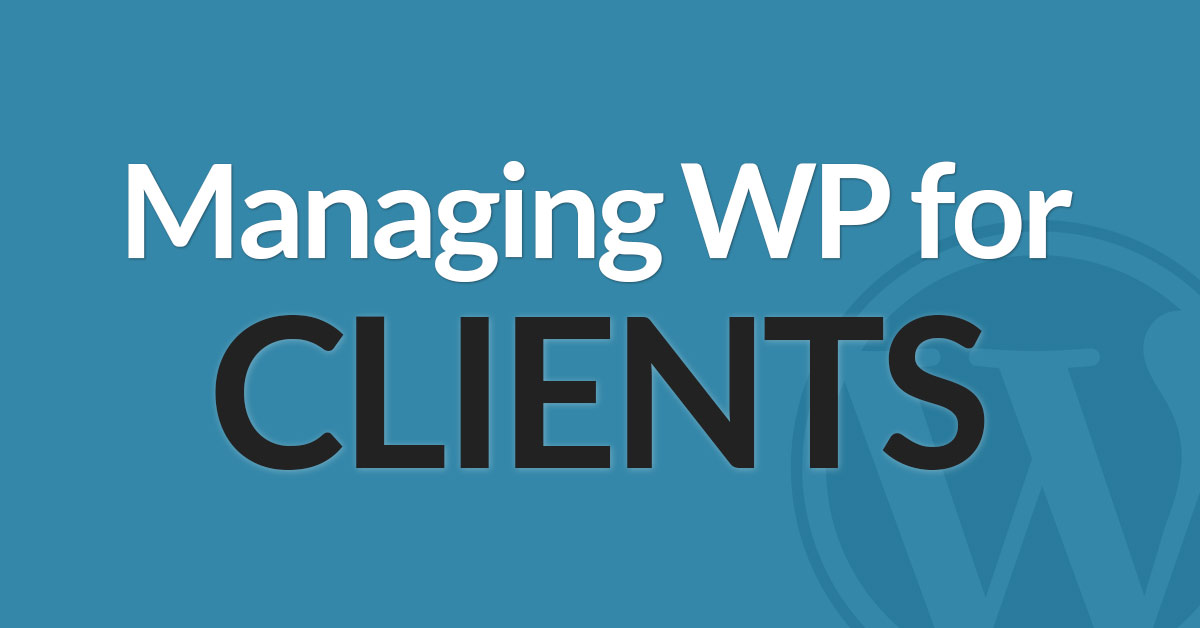
WordPress is the ideal platform to build and manage a web design client website.
It provides a solid framework so you don’t need to manually piece together every feature with code. Plus there are an endless amount of plugins to perfect the customization.
But I want you to think not only about how to manage WordPress for clients, but how to become more involved with their non-WordPress business decisions.
Don’t provide one standalone service, limiting your knowledge and potential income. Become a sponge and absorb wisdom from your clients that are successful, then expand beyond WordPress.
Effective Client Communication
Having dealt with many clients who switched from big website builder companies, I can’t emphasize enough how much they value direct communication.
They got sick of calling customer service centers halfway across the globe, speaking with a different representative each time. Minor issues would drag on for weeks or months at a time. They didn’t have access to the people who were actually coding their website.
This goes back to a common theme with the web design and WordPress industry – it’s non-standard. It ranges from your cousin building a website for free, to a $99/month package with a setup fee, to $50,000 agency level projects – and everything in between.
Small business owners often don’t know the criteria to selecting a “website manager”, and therefore use 2-3 service providers before finding the right match for their needs.
I’ve said it many times, the right clients will give you full control of their online properties once they trust you.
You can offer the best packages with WordPress, but if you aren’t learning more about your client with every interaction, you aren’t building a lasting business relationship.
Put a focus on communication and responsiveness to stand out from cheap alternatives.
15 Tools to Start Your Web Design Business
Want this helpful free giveaway or training?
Best WordPress Plugins
I can think of at least two occasions where I accepted a project, not understanding exactly how to implement it.
WordPress plugins saved me from hours of mental labor in both of those cases.
This is why I recommend specializing with websites for one business type only. The more projects you work on, the deeper your knowledge becomes in a narrow area. Then you can use your curated library of plugins and ignore the ones that don’t matter for that business type.
Because of the wide-range of plugins available, I can only recommend the ones I use consistently for my ideal niche, which is home service and residential contractors:
- WordPress SEO by Yoast – Give every page a boost in the search engines
- Contact Form 7 – Allows my clients to receive leads via e-mail
- Duplicator – Easy way to backup and migrate a WP website
- Sumo – Social sharing and list building tools
As a general rule of thumb, don’t install more than 10 plugins on your WordPress website. As you get into the double-digits, your website may slow down and issues can arise from conflicting plugins.
Keep them to a minimum, add only what is absolutely necessary to benefit your client’s website and make management easier for you.
Add to Your WordPress Toolbox
You cannot expect to master one skill only, and build a career out of it.
If you are learning about building websites, WordPress is the best software to start with in my eyes. And while you can make a living, you probably won’t get rich with one-off freelance work.
The predictable money comes when you are a “swiss-army knife” for your clients. If you can handle more and more small projects in several areas, then you can transition into a consulting role where you are paid a monthly retainer.
I strongly advise anyone learning about websites to delve into two areas at some point:
- Marketing & Advertising
- HTML/CSS Code
You will add a tremendous amount of value if you can have a firm grasp on each of these in addition to being a master with WordPress.
Remember that having a beautiful website does nothing if no one sees it.
When you know how to drive traffic to a website after it is launched, you’ll open up a new realm of opportunity.
You could become enamored with advertising on Facebook and turn to that as your new speciality. It’s impossible to know until you dip your toe into the water.
Create Processes to Stay Organized
I operate with two mindsets.
Mindset #1 is treating work like a test lab. I’m always reading about and using new tools. I want the edge that comes with being the first to adapt to current trends.
This is how I transitioned from hand-coded HTML/CSS websites to WordPress. Then to responsive WP themes. Then driving traffic with Google AdWords and Facebook ads. There are plenty of tools I use on a daily basis outside of the scope of websites, too.
By nature, I enjoy testing out all the “cool stuff” I can get my hands on. I definitely believe this mentality was instilled in me through engineering.
Mindset #2 is understanding when it’s time to organize the clutter. When I sense that overwhelm, I know it’s time to bring structure to my world.
That’s when I take the things that are working, and create a process or system for them. It can be a simple as a list of steps, or more complex by tying in automated services.
But either way, when you arrive at a desirable outcome, document how you got there so you don’t need to reinvent the wheel to do it again.
In terms of managing gigabytes of data for multiple clients, organize all projects into a hierarchical folder structure, and use cloud services so you can access it from anywhere.
My favorites are Dropbox and Google Drive – 90% of what I do ends up on one of these platforms!
Understand Traffic & Lead Generation
As I touched on within the “Develop Your Toolbox” section, expand your skills outside of WordPress. That’s where all the magic happens when it comes to business.
In order to properly plan your off-site approach, think about one question only – who is the ideal website visitor for my client?
Be as specific as you can.
For instance, one of my clients offers roofing and siding services. This means their ideal customer is a homeowner in our target cities/counties with an older home or storm damage that needs immediate attention.
People that fit this description hit these check points:
- They first look for a trusted referral from a friend/family member
- If they don’t get one, they will search Google
- They read reviews, testimonials, and look for other trust factors
- They fill out a contact form or call to schedule an estimate if you are professional
That list tells me my focus managing this roofing website is:
- Build a mobile responsive website
- Include quality photos, testimonials from happy customers, certifications, etc.
- Tell their story as a company and highlight their experience
- Make it easy for people browsing to contact them via e-mail or phone
- Setup a profile on Yelp, Angie’s List, Google+, Facebook, Houzz
- Encourage my client to ask their satisfied customers to leave reviews online
- Add content each month and optimize SEO to rank for local keyword searches
- Test Google AdWords cost-per-click to drive qualified search traffic
This example should indicate how building a website and driving traffic involves a completely unique set of tasks based upon the business niche. If you are building an e-commerce website for a boutique dress shop, it’s a wildly different project.
Once you specify your ideal niche, you’ll understand more than WordPress alone. You can become the decision-maker and voice of reason with your clients’ online real estate because you know their industry.




